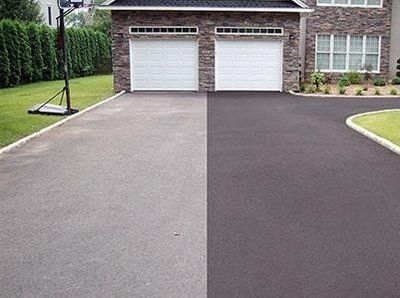Discover the Power of Industrial Parking Lot Leading and Asphalt Sealing
Warm Mix Asphalt: A Sustainable Remedy for Sidewalk
Warm Mix Asphalt (HMA) has actually arised as a leading lasting selection for sidewalk solutions, using a myriad of environmental advantages and innovative technologies. As the demand for environmentally friendly building and construction techniques grows, exploring the subtleties of HMA's sustainability can supply important understandings into the future of pavement remedies.
Ecological Benefits of Warm Mix Asphalt

Furthermore, Warm Mix Asphalt aids to minimize city warm island results. Its dark color absorbs sunshine, reducing the quantity of heat mirrored back into the atmosphere compared to lighter-colored sidewalks. This can decrease ambient temperatures in metropolitan locations, decreasing the demand for air conditioning and eventually minimizing power usage.
On top of that, Hot Mix Asphalt adds to boosted stormwater management. Its permeable nature enables water to charge and infiltrate the pavement groundwater materials, decreasing overflow and the danger of flooding. These ecological advantages make Hot Mix Asphalt a lasting selection for paving highways and roadways.
Power Performance in HMA Manufacturing
Is power effectiveness a vital aspect in the production of Warm Mix Asphalt (HMA)? Definitely. Power plays a significant duty in the production of HMA, influencing both price and ecological sustainability. One crucial element of power efficiency in HMA manufacturing is making use of warm mix asphalt (WMA) technologies (commercial parking lot paving). WMA enables the mixing and placement of asphalt at lower temperature levels compared to conventional hot mix asphalt, resulting in minimized energy intake throughout production. This procedure not only lowers fuel use yet likewise decreases greenhouse gas exhausts, making it a more environmentally friendly alternative.
Moreover, advancements in plant innovations have led to even more energy-efficient HMA production processes. Modern plants are made with functions like recycled asphalt pavement (RAP) processing capabilities, effective burner systems, and improved insulation, all adding to power financial savings. By optimizing energy use in HMA production, the market can lower its carbon footprint while maintaining top quality sidewalk products. Energy efficiency is, consequently, an important factor to consider in ensuring the sustainability of Hot Mix Asphalt manufacturing.
Recyclability of Hot Mix Asphalt
The recyclability of Warm Mix Asphalt (HMA) is a crucial aspect of its sustainability and long-term environmental impact. HMA is among the most recycled materials in the United States, with over 100 million bunches of redeemed asphalt sidewalk (RAP) being reused each year in brand-new sidewalk construction. Reusing HMA uses numerous ecological advantages, such as lowering the demand for virgin products, decreasing energy intake during production, and decreasing the quantity of waste sent out to land fills.
The procedure of recycling HMA entails grating the existing sidewalk, squashing it right into smaller sized pieces, and mixing it with brand-new aggregate and asphalt binder to develop a recycled mix. On the whole, the recyclability of HMA plays a substantial role in advertising sustainable techniques within the pavement industry.

Long-Term Performance of HMA
Asphalt pavements demonstrate longevity and strength over an extensive period, mirroring the long-lasting performance of Warm Mix Asphalt (HMA) The longevity of HMA can be credited to its capacity to hold up against hefty traffic lots, extreme climate condition, and the effects of aging. Research studies have shown that properly designed and correctly built HMA sidewalks can last for here 20 years or even more with regular maintenance. The key to maximizing the long-lasting efficiency of HMA hinges on making use of high-quality products, following finest practices in building and construction, and executing effective maintenance strategies. Correct water drainage, routine assessments, and timely repair work are important for maintaining the structural integrity of HMA pavements in time. Additionally, developments in HMA innovation, such as the use of polymer-modified binders and warm mix asphalt, have actually further boosted the durability and longevity of HMA pavements. By prioritizing high quality building and construction and upkeep methods, HMA remains to prove itself as a sustainable and cost-efficient solution for long-lasting sidewalk framework.

HMA: Sturdiness and Sustainability
Demonstrating both durability and sustainability, Hot Mix Asphalt (HMA) has actually become a keystone in the building and construction of lasting sidewalk facilities - commercial parking lot paving. HMA's toughness originates from its capacity to withstand heavy lots, severe climate condition, and high web traffic quantities, making it a trustworthy choice for highways, freeways, and flight terminal runways. The composition of HMA, which usually includes accumulations, binder, and filler, plays a vital role in boosting its longevity and resistance to tear and wear
Moreover, HMA's sustainability exists in its recyclability and energy-efficient manufacturing process. The capability to reuse redeemed asphalt pavement (RAP) in new HMA mixtures reduces the demand for virgin products and lessens the ecological effect of pavement building and maintenance. Furthermore, the energy efficiency of generating HMA lies in its reduced blending temperatures compared to various other sidewalk products, bring about minimized power intake and greenhouse gas exhausts.
Final Thought
In final thought, warm mix asphalt (HMA) supplies a lasting service for sidewalk with its environmentally pleasant features. HMA's recyclability, energy performance in production, and lasting sturdiness make it an environmentally friendly option for roadway construction.
HMA is one of the most recycled products in the United States, with over 100 million bunches of recovered asphalt sidewalk (RAP) being reused each year in brand-new pavement construction.The procedure of reusing HMA involves crushing the existing sidewalk, crushing it into smaller sized pieces, and mixing it with brand-new accumulation and asphalt binder to create a recycled mix.Asphalt pavements show sturdiness and durability over an extended period, reflecting the long-term efficiency of Hot Mix Asphalt (HMA) In addition, advancements in HMA innovation, such as the usage of polymer-modified binders and cozy mix asphalt, have actually even more improved the sturdiness and durability of HMA sidewalks. The capacity try this out to recycle dig this recovered asphalt pavement (RAP) in brand-new HMA blends decreases the demand for virgin products and minimizes the ecological impact of pavement building and construction and upkeep.